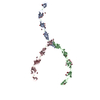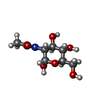+ データを開く
データを開く
- 基本情報
基本情報
| 登録情報 | データベース: PDB / ID: 1q5b | |||||||||
|---|---|---|---|---|---|---|---|---|---|---|
| タイトル | lambda-shaped TRANS and CIS interactions of cadherins model based on fitting C-cadherin (1L3W) to 3D map of desmosomes obtained by electron tomography | |||||||||
 要素 要素 | EP-cadherin | |||||||||
 キーワード キーワード | STRUCTURAL PROTEIN / CADHERIN / TRANS INTERACTION / DESMOSOME / JUNCTION / ADHESION | |||||||||
| 機能・相同性 | 2-acetamido-2-deoxy-alpha-D-glucopyranose 機能・相同性情報 機能・相同性情報 | |||||||||
| 生物種 |  | |||||||||
| 手法 | 電子顕微鏡法 / 電子線トモグラフィー法 / 解像度: 30 Å | |||||||||
 データ登録者 データ登録者 | He, W. / Cowin, P. / Stokes, D.L. | |||||||||
 引用 引用 |  ジャーナル: Science / 年: 2003 ジャーナル: Science / 年: 2003タイトル: Untangling desmosomal knots with electron tomography. 著者: Wanzhong He / Pamela Cowin / David L Stokes /  要旨: Cell adhesion by adherens junctions and desmosomes relies on interactions between cadherin molecules. However, the molecular interfaces that define molecular specificity and that mediate adhesion ...Cell adhesion by adherens junctions and desmosomes relies on interactions between cadherin molecules. However, the molecular interfaces that define molecular specificity and that mediate adhesion remain controversial. We used electron tomography of plastic sections from neonatal mouse skin to visualize the organization of desmosomes in situ. The resulting three-dimensional maps reveal individual cadherin molecules forming discrete groups and interacting through their tips. Fitting of an x-ray crystal structure for C-cadherin to these maps is consistent with a flexible intermolecular interface mediated by an exchange of amino-terminal tryptophans. This flexibility suggests a novel mechanism for generating both cis and trans interactions and for propagating these adhesive interactions along the junction. | |||||||||
| 履歴 |
|
- 構造の表示
構造の表示
| ムービー |
 ムービービューア ムービービューア |
|---|---|
| 構造ビューア | 分子:  Molmil Molmil Jmol/JSmol Jmol/JSmol |
- ダウンロードとリンク
ダウンロードとリンク
- ダウンロード
ダウンロード
| PDBx/mmCIF形式 |  1q5b.cif.gz 1q5b.cif.gz | 351.9 KB | 表示 |  PDBx/mmCIF形式 PDBx/mmCIF形式 |
|---|---|---|---|---|
| PDB形式 |  pdb1q5b.ent.gz pdb1q5b.ent.gz | 263.7 KB | 表示 |  PDB形式 PDB形式 |
| PDBx/mmJSON形式 |  1q5b.json.gz 1q5b.json.gz | ツリー表示 |  PDBx/mmJSON形式 PDBx/mmJSON形式 | |
| その他 |  その他のダウンロード その他のダウンロード |
-検証レポート
| 文書・要旨 |  1q5b_validation.pdf.gz 1q5b_validation.pdf.gz | 862.5 KB | 表示 |  wwPDB検証レポート wwPDB検証レポート |
|---|---|---|---|---|
| 文書・詳細版 |  1q5b_full_validation.pdf.gz 1q5b_full_validation.pdf.gz | 1.1 MB | 表示 | |
| XML形式データ |  1q5b_validation.xml.gz 1q5b_validation.xml.gz | 83.4 KB | 表示 | |
| CIF形式データ |  1q5b_validation.cif.gz 1q5b_validation.cif.gz | 115.8 KB | 表示 | |
| アーカイブディレクトリ |  https://data.pdbj.org/pub/pdb/validation_reports/q5/1q5b https://data.pdbj.org/pub/pdb/validation_reports/q5/1q5b ftp://data.pdbj.org/pub/pdb/validation_reports/q5/1q5b ftp://data.pdbj.org/pub/pdb/validation_reports/q5/1q5b | HTTPS FTP |
-関連構造データ
- リンク
リンク
- 集合体
集合体
| 登録構造単位 | 
|
|---|---|
| 1 |
|
- 要素
要素
| #1: タンパク質 | 分子量: 97753.352 Da / 分子数: 3 / 断片: residues 1-546 of PDB entry 1L3W / 由来タイプ: 天然 / 詳細: Desmosome preparation from newborn mouse skin / 由来: (天然)  #2: 糖 | ChemComp-NAG / #3: 糖 | ChemComp-NDG / #4: 化合物 | ChemComp-CA / 構成要素の詳細 | COMPOUND COMBINED TRANS AND CIS INTERACTION WITH THREE CADHERIN MOLECULES,THE INTERACTION INVOLVED ...COMPOUND COMBINED TRANS AND CIS INTERACTIO | Has protein modification | Y | 配列の詳細 | SEQUENCE SEQUENCE IS TAKEN FROM XENOPUS LAEVIS, AFRICAN CLAWED FROG, SWISSPROT ENTRY P33148, CADF_ ...SEQUENCE SEQUENCE IS TAKEN FROM XENOPUS LAEVIS, AFRICAN CLAWED FROG, SWISSPROT ENTRY P33148, CADF_XENLA BUT THE SOURCE ORGANISM IS MUS MUSCULUS. | |
|---|
-実験情報
-実験
| 実験 | 手法: 電子顕微鏡法 |
|---|---|
| EM実験 | 試料の集合状態: TISSUE / 3次元再構成法: 電子線トモグラフィー法 |
- 試料調製
試料調製
| 構成要素 |
| |||||||||||||||
|---|---|---|---|---|---|---|---|---|---|---|---|---|---|---|---|---|
| 緩衝液 | 名称: PBS with 1mM CaCl2 / pH: 7.4 / 詳細: PBS with 1mM CaCl2 | |||||||||||||||
| 試料 | 包埋: YES / シャドウイング: NO / 染色: NO / 凍結: NO | |||||||||||||||
| 試料支持 | 詳細: 200 mesh copper grid coated with formvar before picking 50nm thin section, then both side coated 5-10 nm thin carbon, imaging at room temperature | |||||||||||||||
| 急速凍結 | 凍結剤: NITROGEN 詳細: high pressure frozen and freezing substituted with 1% OsO4/0.1% Ur-Ac. in acetone, LX-112 resin embeded sample. 50nm thin section | |||||||||||||||
| 結晶化 | *PLUS 手法: 電子顕微鏡法 |
- 電子顕微鏡撮影
電子顕微鏡撮影
| 顕微鏡 | モデル: FEI/PHILIPS CM200FEG / 日付: 2002年11月23日 / 詳細: Dose is for whole dataset, not individual images |
|---|---|
| 電子銃 | 電子線源:  FIELD EMISSION GUN / 加速電圧: 200 kV / 照射モード: FLOOD BEAM FIELD EMISSION GUN / 加速電圧: 200 kV / 照射モード: FLOOD BEAM |
| 電子レンズ | モード: BRIGHT FIELD / 倍率(公称値): 50000 X / 倍率(補正後): 68276 X / 最大 デフォーカス(公称値): 500 nm / 最小 デフォーカス(公称値): 300 nm / Cs: 2 mm |
| 試料ホルダ | 温度: 295 K / 傾斜角・最大: 79 ° / 傾斜角・最小: -78 ° |
| 撮影 | 電子線照射量: 1200 e/Å2 / フィルム・検出器のモデル: GENERIC GATAN / 詳細: 1024x1024 pixels CCD |
- 解析
解析
| EMソフトウェア |
| |||||||||||||||
|---|---|---|---|---|---|---|---|---|---|---|---|---|---|---|---|---|
| CTF補正 | 詳細: no CTF correction. Imaging at underfocus 0.4 micron with CM200FEG microscope at 50,000 magnification | |||||||||||||||
| 対称性 | 点対称性: C1 (非対称) | |||||||||||||||
| 3次元再構成 | 手法: +/- 75 degree dual-axis electron tomography with IMOD 解像度: 30 Å / ピクセルサイズ(実測値): 7.266 Å 倍率補正: CCD pixel size calibrated with gold crystal and silicon crystal 詳細: sectioned sample thickness 47.2 nm; +/- 75 degree dual-axis tilt-series with increment 1 degree, dual-axis electron tomography with IMOD. 1.169nm alignment error 対称性のタイプ: POINT | |||||||||||||||
| 原子モデル構築 | プロトコル: RIGID BODY FIT / 空間: REAL Target criteria: best visual fit using the program AmiraMOL 3.0 詳細: METHOD--tracking 3D density REFINEMENT PROTOCOL--rigid body | |||||||||||||||
| 原子モデル構築 | PDB-ID: 1L3W Accession code: 1L3W / Source name: PDB / タイプ: experimental model | |||||||||||||||
| 精密化ステップ | サイクル: LAST
|
 ムービー
ムービー コントローラー
コントローラー












 PDBj
PDBj








